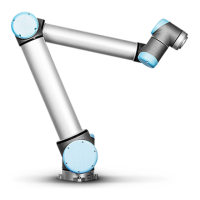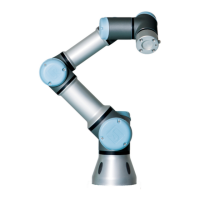The integrator must prevent unauthorized access to the safety configuration by using password
protection.
A collaborative robot application risk assessment for contacts that are intentional and/or due to
reasonably foreseeable misuse is required and must address:
• Severity of individual potential collisions
• Likeliness of occurrence of individual potential collisions
• Possibility to avoid individual potential collisions
If the robot is installed in a non-collaborative robot application where hazards cannot be
reasonably eliminated or risks cannot be sufficiently reduced by use of the built-in safety-related
functions (e.g.when using a hazardous tool/end effector), then the risk assessment conducted
by the integrator must conclude the need for additional protective measures (e.g.an enabling
device to protect the operator during set-up and programming).
Universal Robots identifies the potential significant hazards listed below as hazards that must
be considered by the integrator.
Note: Other significant hazards can be present in a specific robot installation.
1. Entrapment of fingers between robot arm cable connector and base (Joint 0).
2. Entrapment of fingers between robot foot and base (Joint 0).
3. Entrapment of fingers between robot wrist 1 and robot wrist 2 (Joint 3 and Joint 4).
4. Penetration of skin by sharp edges and sharp points on tool/end effector or tool/end
effector connector.
5. Penetration of skin by sharp edges and sharp points on obstacles near the robot track.
6. Bruising due to contact with the robot.
7. Sprain or bone fracture due to strokes between a heavy payload and a hard surface.
8. Consequences due to loose bolts that hold the robot arm or tool/end effector.
9. Items falling out of tool/end effector, e.g. due to a poor grip or power interruption.
10. Mistakes due to different emergency stop buttons for different machines.
11. Mistakes due to unauthorized changes to the safety configuration parameters.
Information on stopping times and stopping distances are found in chapter1.6. Safety-related
Functions and Interfaces on page13 and appendix1.14. Stopping Time and Stopping Distance
on page57.
1.5.8. Emergency Stop
Activate the emergency stop push-button to immediately stop all robot motion.
Note: According to IEC 60204-1 and ISO 13850, emergency devices are not safeguards. They are
complimentary protective measures and are not intended to prevent injury.
The risk assessment of the robot application shall conclude if additional emergency stop buttons
are need. Emergency stop push-buttons must comply with IEC 60947-5-5 (see sectionSafety
I/Oon page33).
User Manual 11 UR10
Copyright © 2009–2020 by UniversalRobotsA/S. All rights reserved.

